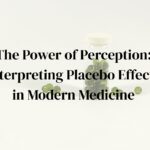
Delving into the annals of medical history, one often discovers seeds of wisdom that have quietly blossomed into the bedrock of contemporary healthcare practices. In this exploration of timeless remedies and pioneering principles, we embark on a journey to unravel how venerable healing traditions have informed and inspired present-day therapeutic innovations. Beyond a mere retrospective, this post promises to enkindle an appreciation for the enduring legacy of medical forethought, offering readers the invaluable perspective of how past practices continue to influence modern treatment and patient care, all through the prism of personal experience within the – albeit evolving – healthcare spheres.
Table of Contents
Embracing Balance: Ancient Dietary Insights in Modern Nutrition
As a fervent advocate for blending time-honored wisdom with contemporary understanding, I often muse on the eating practices of our predecessors. The essence of ancient diets was deeply rooted in the principle of balance, which is resoundingly echoed in today’s pursuit of nutritional equilibrium. My own journey with nutrition has been transformative, guided by the sagacity of the past. Studying the principles of Ayurveda, an ancient Indian practice, I learned the significance of ‘Agni’ or digestive fire and its role in metabolic processes, which parallels our modern concept of digestive enzymes and gut health.
The ancient Greeks, masters of philosophical thought, preached the ethos of moderation. The humoral theory they originated, though obsolete in its specifics, surprisingly aligns with our current understanding that too much or too little of any nutrient can create disharmony in the body. Revisiting age-old dietary customs such as fasting, I’ve found parallels in today’s intermittent fasting, which research suggests can rejuvenate the body in much the same way the Greeks posited centuries ago.
My forays into the ancient Chinese tradition of yin and yang brought to light the concept of foods bringing thermal properties to the body. In the midst of a cold winter, I found solace in warming ginger, much as traditional healers might have. This aligns with modern views on how certain foods can influence inflammation and overall homeostasis.
Even the holistic approach to food selection, with a focus on variety, seasonality, and locality from various ancient cultures, has found its way back to us as a beacon of sustainable and health-focused eating. The resurgence of ancient grains like quinoa and amaranth, staples of Incan and Aztec diets, respectively, is a testament to this. Their rich nutrient profiles and health benefits are being acknowledged as if whispered through the ages by their original cultivators.
Embracing these ancient practices has not just been about discovery, it’s been a journey of realization. Every seed sown in the past has germinated into knowledge that, when nurtured, blossoms into the diverse garden that is modern nutrition. Reflecting on the symbiosis of ancient dietary insights with contemporary science, I am struck with a profound sense of continuity and privilege to partake in a legacy that feeds both body and soul.
Surgical Beginnings: From Battlefield Amputations to Robotic Precision
The surgical theater of today, with its gleaming instruments and robotic devices, is a far cry from the rudimentary and urgent interventions of ancient warfare. My fascination with the evolution of surgical techniques has often led me to marvel at how historical battlefield necessities have forged modern surgical precision. From the gruesome, yet life-saving amputations performed with saws and heated cauteries in the midst of battle, we have arrived at an era where robotic arms perform intricate surgeries with an accuracy that rivals—and often surpasses—the steadiest human hand.
In the throes of combat, with limited resources and knowledge, the ancient medics confronted wounds that threatened life and limb. The birth of surgery was, in many ways, a baptism by fire. Soldiers with damaged limbs left untreated would almost certainly succumb to infection; thus, amputation became a brutal, but an essential life-saving procedure. These harrowing experiences accumulated over centuries, creating a foundation of knowledge that spurred the development of surgical instruments and techniques.
Fast-forward to the present-day operating room, and the contrast is stark. We have entered the era of minimally invasive procedures, where laparoscopes and endoscopes allow surgeons to see inside the body without large incisions. More impressively, robotic surgery stands at the pinnacle of medical innovation. Systems such as the da Vinci Surgical System exemplify the transformative power of technology, providing surgeons with a level of precision that was once unimaginable. The robotic ‘hands’ replicate the surgeon’s movements with dexterity that eliminates the natural tremble of human hands, making delicate procedures less invasive and reducing recovery times significantly.
Each time I have witnessed a robotic surgery, a sense of awe washes over me. It’s a vivid reminder of how far we have come since those primitive battlefield operations. The relentless pursuit of surgical excellence, ignited on ancient battlefields and fanned by the winds of progress, has left an indelible mark on modern medicine. As we continue to push the boundaries of what is possible, we pay silent homage to the medical pioneers of the past—whose desperation and bravery paved the way for the life-saving innovations we benefit from today.
The Herbalist’s Legacy: Plant-Based Pharmaceuticals
Throughout the tapestry of time, the healing powers of plants have been an immutable pillar in the quest for wellness. As a healthcare aficionado, I’ve been mesmerized by the enduring legacy of ancient herbalists and how their wisdom cascades through the ages into our contemporary pharmacies. It’s a story not merely of substances, but of human curiosity, experimentation, and respect for nature’s intricacies.
Take for instance the humble willow tree, once a symbol of solace, its bark led to the discovery of aspirin. My own experience with this age-old remedy during a trek through the woods, chewing on willow bark to alleviate a throbbing headache, connects me to a timeless lineage of healers who relied on the same natural relief. Such practices, recorded as far back as 400 BCE by Hippocrates, reflect a profound understanding of botanical biochemistry that continues to inspire modern analgesics.
Similarly, the foxglove plant, with its beautiful, bell-shaped flowers, conceals within its leaves the roots of digitalis medication. Once used by ancient folk practitioners to treat heart conditions, it echoes its efficacy in today’s digitoxin and digoxin compounds, cornerstone treatments for heart failure and atrial fibrillation. My own brush with the power of foxglove came when observing its carefully metered use under clinical watch, a testament to the respect these powerful botanicals command even now.
The journey of plant-based pharmaceuticals isn’t limited to Western traditions. My explorations have also led me to the rich tapestry of Eastern medicine where the ginkgo tree stands as a beacon of healing. Revered for its memory-enhancing properties, modern research has validated its role in cognitive function, a nod to centuries-old practices of Korean, Chinese, and Japanese herbalists who first unlocked its potential.
As we delve deeper into the genetic blueprint of plants, the revelations continue to unfold in astounding ways. Studies I’ve perused with fervor narrate the tale of turmeric, long venerated in Ayurvedic medicine for its anti-inflammatory prowess, now forming the basis of cutting-edge research in treating chronic diseases and perhaps, even warding off the specters of dementia.
The wisdom of the ancients, enshrined in the genetic codes of the Earth’s verdure, continues to guide us. From ancient scrolls to the sleek glass vials on modern shelves, every plant-derived therapy reflects an unbroken thread of discovery that weaves the old with the new, underscoring our shared human legacy of seeking healing through nature’s bounty.
Mindful Practices: Meditation’s Journey from Monasteries to Clinics
My personal brush with meditation began in the vibrant landscape of my grandmother’s tales, where Buddhist monks emerged as serene envoys of peace. It was here that I learned how these ancient techniques transcended the secluded monasteries, burgeoning into a pivotal element of contemporary clinical therapy. The evolution of meditation from religious ritual to therapeutic practice bears testimony to the adaptability and the enduring nature of this ancient discipline.
In the monastic tradition, meditation was an extensive practice, almost a way of life that sought to achieve spiritual enlightenment. Expanding over centuries, this pursuit of inner peace seeded the idea that mental wellbeing is integral to overall health. My journey led me to delve into how modern psychotherapy now often includes ‘mindfulness meditation’ – a secular adaptation of these monastic exercises that underscores a mental presence and awareness in the moment. The clinical translation involves guiding patients to focus on their breath or sensations, often as part of treatment for anxiety, depression, or stress-related disorders.
It’s fascinating to witness the confluence of scientific research with these ancient rituals. Clinical trials have illuminated our understanding of meditation’s benefits, including neural adaptability, stress reduction, and even structural changes within the brain. As someone passionate about the potential of meditation for healing, I’ve incorporated these practices into my life and seen them ripple through my well-being, like the serene waves of serenity that monks have been riding for ages.
The monastery’s silent echoes seem to reverberate powerfully in today’s bustling hospitals and clinics. I’ve had conversations with healthcare professionals who express awe at the transformation they see in patients who embrace meditation, a sentiment that resonates deeply with me. Health practitioners are becoming avid endorsers of this age-old practice, crowning it as an ally in the modern therapeutic arsenal against an array of ailments.
Indeed, the ancient art of meditation, having traversed the ages and cultures, has experienced a rebirth, morphing into a clinically respected and scientifically supported method aimed at soothing the modern soul. Its journey is a profound echo of the past, creating a harmony that enriches modern medicine with the timeless wisdom of ancestral healing.
The Rebirth of Water Healing: Hydrotherapy Across Ages
The annals of history are steeped with the healing power of water, an element as old as time. Recalling the steamy allure of ancient Roman baths and the sacred springs of Greek sanctuaries, hydrotherapy has woven itself into the fabric of therapeutic practices, heralding its resurgence in modern medicine. It’s fascinating to observe this undying legacy transition into present-day wellness protocols.
In my own explorations, both through written word and personal practice, I’ve engaged with the gentle whispers of water’s curative embrace. Submerging oneself in warm waters, I’ve noted the easing of muscle tension, as if the liquid itself coaxes the stiffness to dissolve, reflecting the age-old practice of balneotherapy. Contrast baths, a dance of hot and cold dips, lure the body’s circulation into a harmonious flow, reminiscent of the spartan vigour in cold rivers and the comforting warmth of sun-touched pools.
Modern hydrotherapy pools and the glistening tiles of spa whirlpools may seem worlds apart from the natural hot springs of our ancestors, yet the underlying principle remains: water is a healer. Watsu, a form of aquatic therapy combining elements of shiatsu massage and stretching while cradled in warm water, has been a transformative experience for me, linking the tactile human connection to the supportive nature of water.
Aquatic exercises have not only become integral components of rehabilitation for the injured but also for older adults seeking to maintain mobility. Through my work, I’ve witnessed the elderly regain confidence in their stride within the security of the water’s embrace, a testament to the ageless relevance of hydrotherapy.
The continuity of water’s therapeutic journey, from the sacred rivers and bathhouses to today’s contemporary hydrotherapy treatments, serves as a humbling reminder that we are merely ripples in the vast ocean of medical history. Yet, we possess the responsibility to carry on this rich heritage, ensuring its vitality for generations to come.
Conclusion
The tapestry of medical evolution is rich with threads spun from historical insights and practices that have elegantly woven into today’s medical tapestries. Whether it’s the food we eat, the operations we undergo, or the mental health strategies we employ, the echoes of ancestral wisdom resound with clarity and insight. Through understanding such connections, we not only gain a deeper appreciation of our current treatments but also a hopeful anticipation for future breakthroughs that may one day, too, become historical landmarks in their own right.



